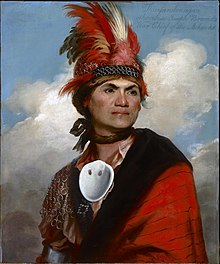Our website is made possible by displaying online advertisements to our visitors.
Please consider supporting us by disabling your ad blocker.
Mohawk people
This article has multiple issues. Please help improve it or discuss these issues on the talk page. (Learn how and when to remove these messages)
|
Kanienʼkehá꞉ka | |
|---|---|
 | |
| Regions with significant populations | |
| Canada (Quebec, Ontario) | 33,330[1] |
| United States (New York) | 5,632 |
| Languages | |
| English, Mohawk, French, Formerly: Dutch, Mohawk Dutch | |
| Religion | |
| Karihwiio, Kanohʼhonʼio, Kahniʼkwiʼio, Christianity, Longhouse, Handsome Lake, Other Indigenous Religion | |
| Related ethnic groups | |
| Seneca Nation of New York, Oneida Nation of Wisconsin, Cayuga Nation of New York, Onondaga Nation, Tuscarora Nation, other Iroquoian peoples | |

The Mohawk, also known by their own name, Kanien'kehà:ka (lit. 'People of the flint'[2]), are an Indigenous people of North America and the easternmost nation of the Haudenosaunee, or Iroquois Confederacy (also known as the Five Nations or later the Six Nations).
Mohawk are an Iroquoian-speaking people with communities in southeastern Canada and northern New York State, primarily around Lake Ontario and the St. Lawrence River. As one of the five original members of the Iroquois Confederacy, the Mohawk are known as the Keepers of the Eastern Door who are the guardians of the confederation against invasions from the east.
Today, Mohawk people belong to the Mohawk Council of Akwesasne, Mohawks of the Bay of Quinte First Nation, Mohawks of Kahnawà:ke, Mohawks of Kanesatake, Six Nations of the Grand River, and Saint Regis Mohawk Tribe, a federally recognized tribe in the United States.[3]
At the time of European contact, Mohawk people were based in the valley of the Mohawk River in present-day upstate New York, west of the Hudson River. Their territory ranged north to the St. Lawrence River, southern Quebec and eastern Ontario; south to greater New Jersey and into Pennsylvania; eastward to the Green Mountains of Vermont; and westward to the border with the Iroquoian Oneida Nation's traditional homeland territory.
- ^ "Canada Census Profile 2021". Census Profile, 2021 Census. Statistics Canada Statistique Canada. 7 May 2021. Retrieved 3 January 2023.
- ^ "HAUDENOSAUNEE GUIDE FOR EDUCATORS" (PDF). National Museum of the American Indian. 2009. Retrieved 6 May 2024.
- ^ "Meet the People". National Museum of the American Indian. Retrieved 16 May 2024.
Previous Page Next Page


